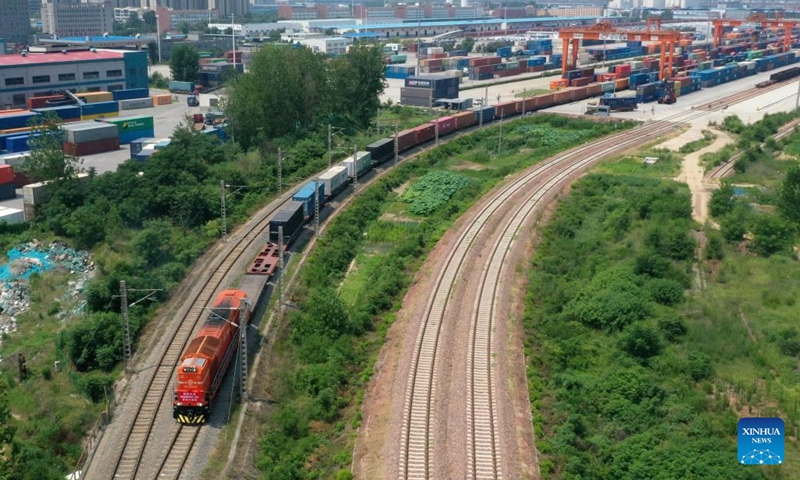75 years on, with strong CPC leadership, clear road map, China’s path inspires world

Illustration: Xiong Xiaoying/GT
Several key statistics are some of the footnotes that the People's Republic of China has written over the past 75 years: GDP per capita has risen from a few dozen dollars in 1952 to $12,700 in 2023, average life expectancy has increased from 35 years to 78.6 years, and railway mileage has expanded from 22,000 kilometers to 159,000 kilometers, including 45,000 kilometers of high-speed rail…
There are more comparisons across various sectors which demonstrate how China is marching forward with solid steps.
At this historic juncture, it is crucial to understand what kind of path China has taken and what has empowered its great strides.
The answers not only shed light on China's further quest for modernization but also offer inspiration for the rest of the world, particularly the Global South, in face of development challenges.
Strong leadership
China's modernization steps have been and will continue to be solid only under the leadership of the Communist Party of China (CPC).
Yang Xuedong, director of the Department of Political Sciences at Tsinghua University, saw the leadership in three layers - pioneer in exploration, the central pillar to unite all, and the ultimate guarantee in a crisis.
The CPC is "a pioneer" in the senses of both ideology and practice, Yang told the Global Times.
The CPC has envisioned the country's future path through the pursuit of Chinese modernization. With nearly 100 million Party members at different positions in all walks of life, the CPC also leads the effort in practice, Yang continued.
Cohesion is vital for a country as unique as China, with its huge population, vast landscape, diverse ethnicities and cultures, and varying interests of different groups, analysts said.
With Party organizations at various levels, the CPC effectively mobilizes people toward a common goal, Yang said.
The CPC has also acted as a safeguard during major challenges, Yang noted.
China's socialist cause had faced setbacks, but we can always overcome challenges with a strong leadership, analysts said.
In face of profound global changes unseen in one century, the CPC fulfills its role in the duty of every Party member, as they participate in rural revitalization in villages, safeguard national sovereignty and territorial integrity along both land and sea borders, and strive to tackle cutthroat problems and make scientific and technological breakthroughs, they said.
Clear road map
China's path has a clear goal of achieving Chinese modernization and national rejuvenation, and a well-defined road map is guiding the great cause, Yang said.
President Xi Jinping first introduced the concept of Chinese modernization in a speech he delivered to mark the CPC's centennial in July 2021.
During the 20th CPC National Congress held in October 2022, Xi delivered a report which clarified five features of Chinese modernization, as well as the essential requirements and major principles of it.
In July 2024, the third plenum of the 20th CPC Central Committee adopted a resolution on further deepening reform comprehensively to advance Chinese modernization.
According to analysts, there is a clear trajectory for how Chinese modernization was envisioned, enriched, and will be realized step by step.
Yang particularly highlighted the keyword "people," which is crucial for this trajectory to succeed.
A people-centered philosophy is reflected in China's system of democracy, its governance and pursuit of high-quality development. Yang said that China can pool all resources to complete major missions, overcome difficulties, and ensure that the fruits of development are shared by the people.
Bojan Lalic, director of the Belt and Road Institute in Belgrade, noted that China's modernization is a comprehensive model with focus on the state's role, and the objectives incorporate development of infrastructure, technology and innovation, together with social progress.
China also prioritizes environment and ecology, as well as sustainable development, and values culture and tradition in the process of modernization, Lalic said.

An aerial drone photo shows a China-Europe freight train pulling out of Putian Station in Zhengzhou, central China's Henan Province, July 18, 2023. Strategically positioned in central part of the country, Henan has been serving as a national hub of transporation for ages. The past decades saw the province building a modern transportation network consisting air flights, railways, highways, water channels and all sorts of ports. It is now rapidly extending its role to areas of cross-border logistics, investment, and trade to facilitate the dual circulation of domestic and international markets. Photo: Xinhua
Inspiration for world
China's modernization is not only meaningful for the 1.4 billion Chinese people, or one-fifth of the world's population, but also offers development opportunities for others through initiatives such as the Belt and Road Initiative (BRI) and the three global initiatives - the Global Development Initiative, the Global Security Initiative and the Global Civilization Initiative, analysts said.
China has signed more than 230 BRI cooperation agreements with more than 150 countries and more than 30 international organizations, according to the National Bureau of Statistics.
Beyond immediate economic benefits, China engages in knowledge sharing and cultural exchanges with other countries and regions, showcasing the benefits of collaboration and a collective approach, Lalic said.
Hamad Al Hosani, a senior research fellow at think tank TRENDS Research and Advisory in the United Arab Emirates, told the Global Times that in contrast to rapid democratization as advocated by Western-style modernization, China's approach has been more gradual, emphasizing economic development alongside social and political continuity.
The Chinese path demonstrated the importance of long-term planning, and the value of tailoring modernization strategies to each country's unique historical, cultural, and social context, Hosani noted.
Lalic said he believes China's modernization journey provides pragmatic and adaptable insights for countries and regions facing development challenges.
Countries can tailor approaches to their unique contexts while striving for sustainable growth and development, "the key is China is replacing zero-sum game with win-win cooperation," Lalic noted.
President Xi has often said that only the wearer of the shoes knows if they fit or not, according to Xinhua.
China's experience challenges the belief that Western-style democracy and capitalism are the only viable paths to modernization, and offers an alternative approach and contributes Chinese wisdom to global development, analysts said.
For the world, China's modernization demonstrates how different governance models can coexist, promoting a more pluralistic understanding of progress and global cooperation, Hosani noted.


